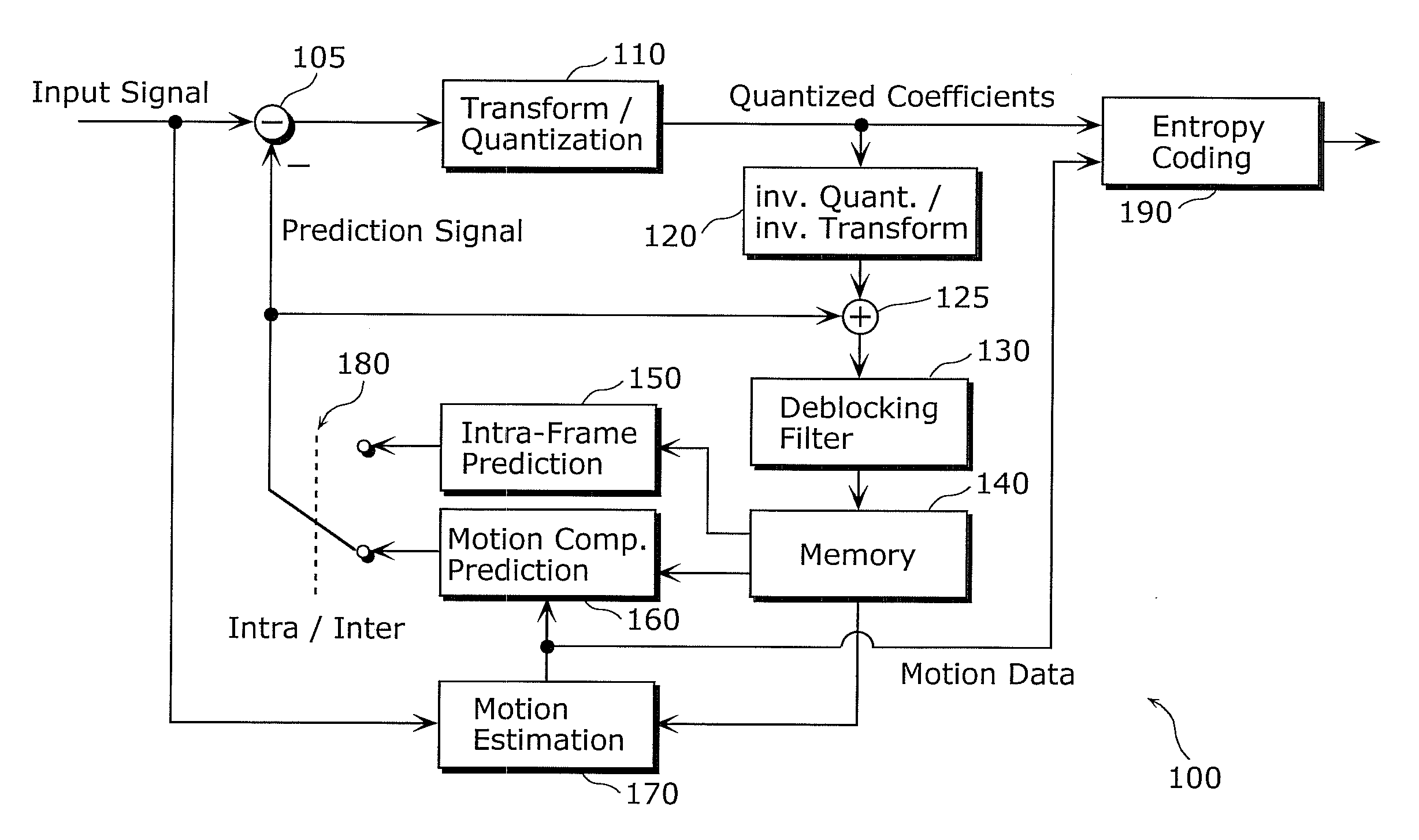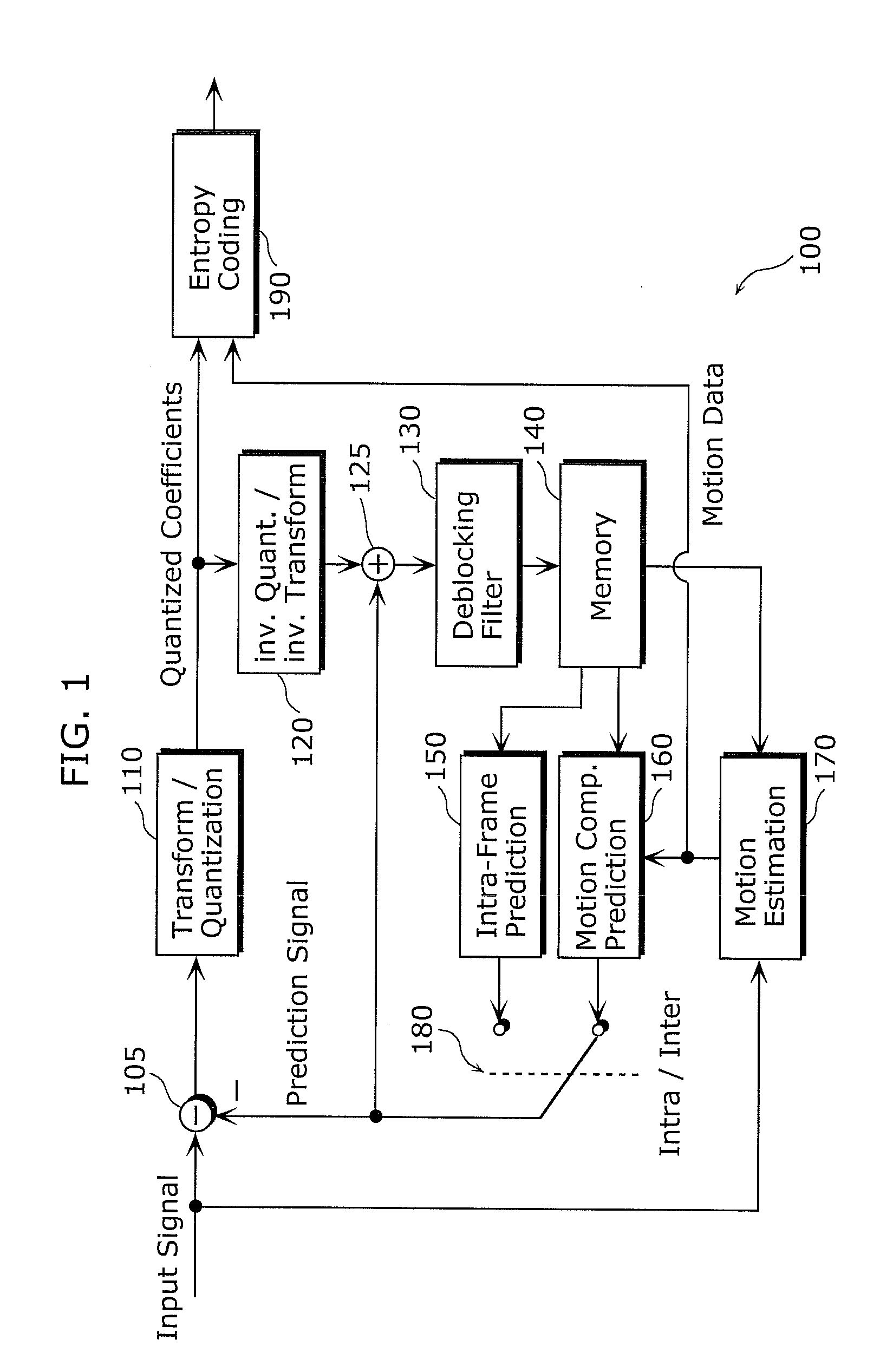Image coding method, image decoding method, image coding apparatus, image decoding apparatus, integrated circuit and program
a technology of image coding and decoding, applied in the field of compression and decompression of video data, can solve the problems of increasing the complexity of encoding, requiring signaling of transformation parameters, and affecting human visual perception, so as to achieve the same image quality and more efficient coding or decoding of images
- Summary
- Abstract
- Description
- Claims
- Application Information
AI Technical Summary
Benefits of technology
Problems solved by technology
Method used
Image
Examples
first embodiment
[0126]The problem underlying the present invention is based on the observation that employing the same scan for transformation coefficients of the image blocks with different content characteristics, such as direction and / or sharpness of edges, may lead to varying efficiency of the encoding applied afterwards. This is caused by the non-stationary statistics of the transformation coefficients of different blocks within an image or an image sequence (video).
[0127]In order to solve this problem, the present invention provides a method for encoding, a method for decoding, an apparatus for encoding (encoder) and an apparatus for decoding (decoder) of image data divided into blocks of pixels. Accordingly, the scanning of the transformation coefficients in a current block is performed sequentially according to the scan order which has been determined based on the values of coefficients of the current block.
[0128]In hybrid image and video coding, an image is typically divided into blocks. T...
second embodiment
[0197]The processing described in the above embodiment can be simply implemented by an independent computer system, by recording, in a recording medium, a program for implementing the configurations for the image coding method and the image decoding method described in the above embodiment. The recording medium may be any recording medium as long as the program can be recorded, such as a magnetic disc, an optical disc, a magnetic optical disc, an IC card, and a semiconductor memory.
[0198]Hereinafter, the applications to the image coding method and the image decoding method described in the above embodiment and systems using thereof will be described.
[0199]FIG. 16 illustrates an overall configuration of a content providing system ex100 for implementing content distribution services. The area for providing communication services is divided into cells of desired size, and base stations ex106 to ex110 which are fixed wireless stations are placed in each of the cells.
[0200]The content pr...
third embodiment
[0235]Each of the image coding method, the image coding apparatus, the image decoding method, and the image decoding apparatus in each of the above embodiments is typically achieved in the form of an integrated circuit or a Large Scale Integrated (LSI) circuit. As an example of the LSI, FIG. 23 illustrates a configuration of the LSI ex500 that is made into one chip. The LSI ex500 includes elements ex501 to ex509 to be described below, and the elements are connected to each other through a bus ex510. The power supply circuit unit ex505 is activated by supplying each of the elements with power when power is on.
[0236]For example, when coding is performed, the LSI ex500 receives an AV signal from a microphone ex117, a camera ex113, and others through an AV IO ex509 under control of a control unit ex501 including a CPU ex502, a memory controller ex503, and a stream controller ex504. The received AV signal is temporarily stored in a memory ex511 outside the LSI ex500, such as an SDRAM. Un...
PUM
 Login to View More
Login to View More Abstract
Description
Claims
Application Information
 Login to View More
Login to View More - R&D
- Intellectual Property
- Life Sciences
- Materials
- Tech Scout
- Unparalleled Data Quality
- Higher Quality Content
- 60% Fewer Hallucinations
Browse by: Latest US Patents, China's latest patents, Technical Efficacy Thesaurus, Application Domain, Technology Topic, Popular Technical Reports.
© 2025 PatSnap. All rights reserved.Legal|Privacy policy|Modern Slavery Act Transparency Statement|Sitemap|About US| Contact US: help@patsnap.com



